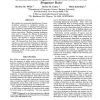Free Online Productivity Tools
i2Speak
i2Symbol
i2OCR
iTex2Img
iWeb2Print
iWeb2Shot
i2Type
iPdf2Split
iPdf2Merge
i2Bopomofo
i2Arabic
i2Style
i2Image
i2PDF
iLatex2Rtf
Sci2ools
ISMB
1993
1993
Transmembrane Segment Prediction from Protein Sequence Data
Weconsider tile automatedidentification of transmembrane domains in membrane protein sequences. 324 proteins (containing 1585 segrrmnts) werc examined, representing every protein in the PIR database having the transmembrane domain feature annotation. Machine learning techniques were used to evaluate the efficacy of alternative hydrophobieity measures and windowing techniques. Wedescribe a simpler measure of taydrophobicity and a newvariable windowsize concept. Wedemonstrate that these techniques are superior to some previous techniques in minimizing the segment error rate. Using these newtechniques: we describe an algorithm that has a 7.9% segment error rate on the sampled proteins, while classifying 16.7%of the anfino acid residues as transmembrane.
Computational Biology | ISMB 1993 | Segment Error Rate | Transmembrane Domain | Transmembrane Domain Feature |
| Added | 02 Nov 2010 |
| Updated | 02 Nov 2010 |
| Type | Conference |
| Year | 1993 |
| Where | ISMB |
| Authors | Sholom M. Weiss, Dawn M. Cohen, Nitin Indurkhya |
Comments (0)

